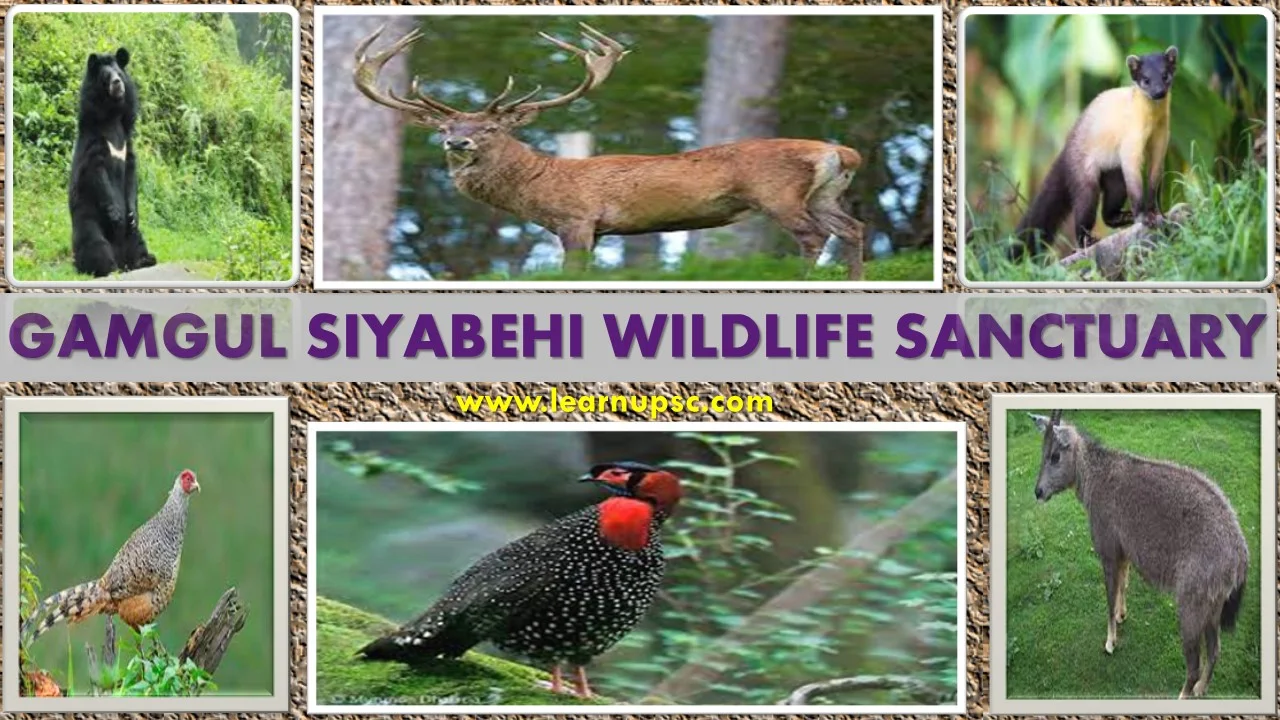Gamgul Siyabehi Wildlife Sanctuary UPSC
Gamgul Wildlife Sanctuary is a high-altitude sanctuary located in the state of Himachal Pradesh, India. The sanctuary is known for being the only one in Himachal Pradesh to have reported sightings of the Kashmir stag (Cervus elaphus hanglu), a rare and magnificent species that inhabits the upper ranges of the Himalayas.
Gamgul Siyabehi Wildlife Sanctuary is home to various bird species, including globally threatened species like Western Tragopan and Cheer Pheasant. The sanctuary is situated within the Western Himalayas Endemic Bird Area.
The sanctuary is not only significant for its diverse flora and fauna but also for its role in the conservation of globally threatened species, particularly the rare pheasants and high-altitude forest birds. It covers a range of altitudes and habitats, making it an important protected area for the preservation of these species.
|
Table of Contents
|
Gamgul Siyabehi Wildlife Sanctuary Location
Gamgul Siyabehi Wildlife Sanctuary is located in the Bhandal Valley of Salooni Tehsil in Chamba District, Himachal Pradesh, India. It shares its northern boundary with the Doda district of the Jammu and Kashmir region. The sanctuary is situated in the high-altitude regions of the Himalayas.
Nearest Airport:
The nearest airport to Gamgul Siyabehi Wildlife Sanctuary is likely to be Kangra Airport, also known as Gaggal Airport. It is situated in Gaggal near Dharamshala in the Kangra district of Himachal Pradesh, India. The distance between Kangra Airport and Gamgul Siyabehi Wildlife Sanctuary is approximately 180-200 kilometers, depending on the specific route taken.
Nearest Railway Station:
The nearest major railway station to Gamgul Siyabehi Wildlife Sanctuary is likely to be Pathankot Railway Station, located in Pathankot city of Punjab, India. From Pathankot, you would need to continue your journey by road to reach the sanctuary. The distance between Pathankot Railway Station and Gamgul Siyabehi Wildlife Sanctuary is approximately 150-170 kilometers, depending on the specific route taken.
Gamgul Siyabehi Wildlife Sanctuary History
Gamgul Siyabehi Wildlife Sanctuary stands as a testament to the region's commitment to conserving its rich natural heritage. Established in the year 1974, this sanctuary emerged as a crucial haven for a diverse array of flora and fauna, reflecting the profound importance of safeguarding the delicate Himalayan ecosystem.
Gamgul Siyabehi Wildlife Sanctuary Area
The Gamgul Siyabehi Wildlife Sanctuary covers an area of approximately 108.85 square kilometers. It spans an elevation range of 1,800 meters to 4,000 meters above sea level, encompassing a gradient of habitats, from lower valleys to higher alpine zones.
Gamgul Siyabehi Wildlife Sanctuary River
The Gamgul Siyabehi Wildlife Sanctuary is bordered by the Siul Nallah, a river that flows along its western boundary. The presence of this river adds to the sanctuary's ecological diversity and significance.
Gamgul Siyabehi Wildlife Sanctuary Valley (Bhandal Valley)
Bhandal Valley is a picturesque and ecologically significant area located in the Salooni Tehsil of Chamba District, Himachal Pradesh, India. This valley is known for its natural beauty, diverse landscapes, and rich biodiversity. It is home to the Gamgul Siyabehi Wildlife Sanctuary, which is nestled within its confines.
Bhandal Valley serves as a habitat for various wildlife species and supports a range of ecosystems, from lower elevations to higher alpine regions. The presence of the Gamgul Siyabehi Wildlife Sanctuary in the Bhandal Valley underscores its importance as a conservation area dedicated to preserving the region's unique flora and fauna.
The valley's combination of hills, forests, rivers, and varied vegetation contributes to its ecological significance and makes it an appealing destination for nature enthusiasts, researchers, and those seeking to explore the natural wonders of Himachal Pradesh.
Gamgul Siyabehi Wildlife Sanctuary Flora
The Gamgul Siyabehi Wildlife Sanctuary boasts a diverse range of flora that is adapted to the unique and varied elevations within its boundaries. Here are some of the notable elements of the sanctuary's flora:
(1) Alpine Pastures (Above 3,000 meters):
These high-altitude pastures are home to hardy grasses, shrubs, and other vegetation that have adapted to the challenging conditions of the upper elevations.
(2) Western Mixed Coniferous Forest:
This forest type features a mix of coniferous trees, including Deodar Cedrus deodara and Pine Pinus wallichiana. These trees are well-adapted to the cooler climate of the region.
(3) Moist Deodar Forest:
Deodar (Cedrus deodara) trees dominate this forest type, creating a lush and cool environment. Deodar is a prominent coniferous species in the region.
(4) Other Species:
In addition to the native flora, the Forest Department has introduced tree species like Poplar (Populus sp.) for commercial purposes. The sanctuary may also support a variety of understorey plants, wildflowers, and other vegetation that contribute to its overall biodiversity.
Gamgul Siyabehi Wildlife Sanctuary Fauna (Gamgul Siyabehi Wildlife Sanctuary Animals)
The Gamgul Siyabehi Wildlife Sanctuary is home to a diverse array of fauna, ranging from rare and elusive species to more common wildlife that thrive in the Himalayan region. Here are some of the notable animals that can be found within the sanctuary:
Mammals:
- Kashmir Stag (Hangul)
- Ibex
- Musk Deer
- Serow
- Himalayan Tahr
- Asiatic Black Bear
- Brown Bear
- Leopard
- Red Fox
- Himalayan Weasel
- Jungle Cat
- Barking Deer or Indian Muntjak
- Indian Porcupine
- Common Giant Flying Squirrel
- Goral
- Yellow-throated Marten
- Himalayan Palm Civet
Birds:
- Western Tragopan
- Cheer Pheasant
- Himalayan Monal
- Koklass Pheasant
Reptiles:
- Various snake species
- Lizards
Gamgul Siyabehi Wildlife Sanctuary UPSC Questions
Q. In which district of Himachal Pradesh is Gamgul Siyabehi Wildlife Sanctuary located?
A. The Gamgul Siyabehi Wildlife Sanctuary is located in the Chamba District of Himachal Pradesh, India. This district is situated in the northern part of the state and is known for its scenic beauty, diverse landscapes, and rich biodiversity.
The sanctuary is nestled within the Bhandal Valley of the Chamba District, contributing to the region's conservation efforts and providing a habitat for various flora and fauna adapted to the Himalayan environment.


No comments:
Post a Comment